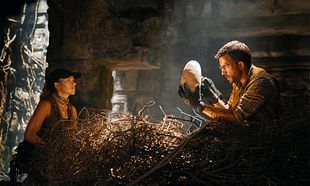Nick Yarris sits down in front of David Sington’s camera and regales us in quite a tale: why, after twenty years on Death Row, Yarris, who always maintained his innocence, wrote to the judge to cancel the appeal process and commence with his execution.
Essentially a one-man show, the articulate and sensitive Yarris proves to be quite the confessor and storyteller. Life on Death Row is dealt with in detail – how speaking is banned – and little vignettes (the rule of silence is broken by a duet of lovers soon to be split into different prisons) are beautifully told. Yarris falls in love with books, particularly crime novels, and sets himself a task of learning fifty new words a day (triskaidekaphobia – the fear of 13 being one of them). He meets ‘Jackie’, a death penalty abolitionist who would visit to determine the mental wellbeing of prisoners. Then there’s his daring escape where he lasts twenty-five days on the run before recapture. It’s enthralling and exhilarating stuff.
But it’s only half way through when Yarris edges into why he is on Death Row. Stopped on the side of the road in a stolen car in 1981, the stoned Yarris gets into a tussle with the arresting officer. The gun goes off and Yarris is overpowered and bungled into the back of the police car. A ridiculous charge of attempting to kidnap and murder the policeman follows and in an effort to ease his conviction, Yarris sets about stitching up a fellow addict of the then-unsolved rape and murder of a woman in a parking lot. However, the plan backfires with suspicion of the murder turning to Yarris who, through a reliance of circumstantial evidence, is sentenced to death. To say any more would do the documentary a disservice but there are more twists and turns and astonishing reveals to be had.
While reminiscent of stripped back style Errol Morris’ work, The Fear of 13 is very similar to the recent The Green Prince; director David Sington (The Flaw) breaks up the ‘play’ with moody pans of cells, cellblocks, showers, streets and whatnot but resists the urge to fully embrace a re-enactment. Despite the unfussy direction from Sington, who is content to let the camera roll on Yarris and let him to the heavy lifting, the documentary has pace with a lot of energy coming from Yarris’ impassioned delivery; obviously rehearsed, Sington lets a few verbal trip ups go by to encourage one to forget the staged setting.
Simply wonderful.








































































